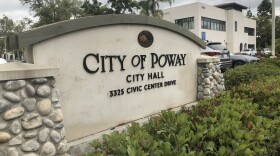The stock market is in the midst of its biggest retreat since the financial crisis.
The Dow Jones industrial average closed down 513 points Thursday afternoon. It is now down more than 1,200 points since July 21.Thursday's losses turned the blue-chip stock index negative for the year.
The Standard & Poor's 500 index is down 3 percent, bringing it nearly 11 percent below its recent high of 1,363 reached on April 29. A decline of 10 percent or more is considered to be a market correction.
Investors are increasingly worried about economic weakness in the U.S. and a debt crisis in Europe.
"We are continuing to be bombarded by worries about the global economy," said Bill Stone, chief investment strategist at PNC Financial.
The Dow Jones industrial average was down 330 points, or 2.8 percent, to 11,566 in afternoon trading. The S&P 500 lost 39, or 3.1 percent, to 1,221. The Nasdaq composite shed 86, or 2.3 percent, to 2,606. The losses put the Dow on track for its biggest one-day drop since October 2008.
Oil fell 6 percent to $87 a barrel on worries demand will fall because of the slowing economy. Oil had traded over $100 as recently as June 9. The yield on the two-year Treasury note hit a record low as investors sought out relatively stable investments.
The Vix, a measure of investor fear, shot up nearly 25 percent. It is up 77 percent for the quarter, which began July 1.
Stock trading has been volatile this week because of concerns that the U.S. economy is weakening. Manufacturing, consumer spending and hiring by private companies are below levels that are consistent with a healthy economy. Those reports have called into question estimates from economists, including Federal Reserve Chairman Ben Bernanke, that the economy will grow more quickly in the second half of the year.
More than 10 stocks fell for every one that rose on the New York Stock Exchange Thursday. Money poured into investments that are seen as relatively safe when markets are turbulent. The yield on the 10-year Treasury note fell to 2.51 percent, its lowest level of the year. The yield on the 2-year Treasury note hit a record low of 0.265 percent. Bond yields fall when demand for them increases.
Mark Luschini, chief investment strategist for Janney Montgomery Scott, an investment firm in Philadelphia, said some clients are moving to cash "as a parking lot to sort things out."
"With the scars of 2008 still fresh, some clients don't want to miss the chance to pre-empt further damage should it come," Luschini said.
Large investors have moved so much money into cash accounts at Bank of New York that on Thursday the bank said it would begin charging some clients a 0.13 percent fee to hold their cash.
"In the past month, we have seen a growing level of deposits on our balance sheet from clients seeking a safe-haven in light of the global interest rate and credit environment," the bank said in a statement to The Associated Press. Bank of New York clients include pension funds and large investment houses.
"Investors are deciding that now is the time to take risk off the table," said Brian Gendreau, market strategist for Cetera Financial Group. Gendreau said that some investors are now wondering whether stocks will have a prolonged slump similar to the aftermath of the Great Depression.
Technical trading, a term used to signify buying or selling based on the S&P 500's prior highs and lows, also helped push stocks downward. The S&P 500 fell below 1,222, a so-called support level, early in the day. That signified to some traders that the stock market would continue to slide.
"Traders are respecting the technical levels even if they're not technicians," said Quincy Krosby, market strategist at Prudential Financial. "Even if you're what we call a conviction buyer, you have to respect those levels."
European stocks fell broadly because of concerns that Italy or Spain may need help from the European Union. The benchmark stock indexes in Italy, Germany and England each fell 3 percent.
Companies that outperform when the global economy expands fell the most. Caterpillar Inc. fell nearly 6 percent, and Chevron Corp. fell 5 percent.
Some traders are selling ahead of Friday's employment report, which is expected to show that unemployment remained at 9.2 percent last month. A rise in the unemployment number would likely push stocks lower again.
The U.S. government said before the market opened that the number of people who applied for unemployment benefits for the first time was only slightly lower last week to 400,000. That's still above the 375,000 level that economist say indicates a healthy job market. It was the latest indication of weakness in the U.S. economy.
All 10 industry groups in the S&P index fell. Energy, materials and industrial companies each lost 5 percent or more.
The sell-off comes at a time when corporate profits are growing. The forward price to earnings ratio of the S&P 500 has fallen to about 12, well below its long-term average of 16. That means that investors who buy now are paying less for each dollar in profits.
Based on what an investor now pays for corporate profits, stocks are now trading at their lowest levels in 20 years, said Tim Courtney, chief investment officer of Burns Advisory Group in Oklahoma City.
Few companies were spared in the sell-off. Just 9 of the 500 stocks in the S&P 500 moved higher. General Motors Co. fell 4 percent despite beating analyst estimates.
The stock market had its biggest fall since the start of the current bull market in March, 2009. The Dow tumbled its largest amount since the height of the financial crisis in 2008. The drop in the S&P was the largest since a 45-point fall on Jan. 20, 2009.





